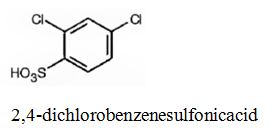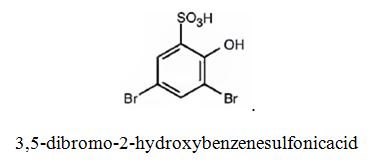
a)

Interpretation:
The major product(s) obtainable from sulfonation of fluorobenzene is/are to be predicted.
Concept introduction:
The substituents attached to the ring have a strong influence on the incoming electrophile. Electron releasing substituent groups, except halogens, activate the ring and direct the incoming electrophile to the o- and p- positions. Halogens are o- and p- directors but they deactivate the ring. Electron withdrawing substituent groups deactivate the ring and direct the incoming electrophile to the m- position.
To predict:
The major products obtainable from sulfonation of fluorobenzene.
Answer to Problem 51AP
The major products obtainable from sulfonation of fluorobenzene are o-flurobenzenesulfonic acid and p- flurobenzenesulfonic acid.

Explanation of Solution
Fluorine attached to an aromatic ring is an o- and p- directing deactivating group. Hence it directs the electrophile, SO3H+ to these positions.

The major products obtainable from sulfonation of fluorobenzene are o-flurobenzenesulfonic acid and p- flurobenzenesulfonic acid.

b)

Interpretation:
The major product(s) obtainable from sulfonation of m-bromophenol is/are to be predicted.
Concept introduction:
Electrophilic substitution of disubstituted benzenes follows three simple rules. (i) If the directing influence of both the substituents reinforce each other, a single product results. (ii) If the directing influences of both the substituent groups oppose each other, the most powerful activating group among them has the dominant influence but usually a mixture of products results. (iii) In meta disubstituted compounds, further substitution in between the groups occurs only rarely, due to steric reasons.
To predict:
The major product(s) obtainable from sulfonation of m-bromophenol.
Answer to Problem 51AP
The major products produced during the sulfonation of m-bromophenol are 2-bromo-4-hydroxybenzenesulfonicacid (I) and 4-bromo-2-hydroxybenzenesulfonicacid (II).

Explanation of Solution
The Br is an ortho and para directing and deactivating group while -OH group is also an ortho and para directing and highly activating group. Hence the -OH group decides the position at which the electrophilic substitution reaction will occur. The electrophile, SO3H+, enters into the ortho and para positions with respect to -OH group to produce 2-bromo-4-hydroxybenzenesulfonicacid (I) and 4-bromo-2-hydroxybenzenesulfonicacid (II).

The major products produced during the sulfonation of m-bromophenol are 2-bromo-4-hydroxybenzenesulfonicacid (I) and 4-bromo-2-hydroxybenzenesulfonicacid (II).

c)

Interpretation:
The major product(s) obtainable from sulfonation of m-dichlorobenzene is/are to be predicted.
Concept introduction:
Electrophilic substitution of disubstituted benzenes follows three simple rules. (i) If the directing influence of both the substituents reinforce each other, a single product results. (ii) If the directing influences of both the substituent groups oppose each other, the most powerful activating group among them has the dominant influence but usually a mixture of products results. (iii) In meta disubstituted compounds, further substitution in between the groups occurs only rarely, due to steric reasons.
To predict:
The major product(s) obtainable from sulfonation of m-dichlorobenzene.
Answer to Problem 51AP
The major product produced during the sulfonation of m-dichlorobenzene is 2,4-dichlorobenzenesulfonicacid.

Explanation of Solution
In electrophilic substitution reactions, Cl is an ortho and para directing and deactivating group. Hence the electrophile, SO3H+, can enter into the ortho and para positions with respect to both Cl atoms. The ortho position in between the two Cl atoms is not favored for steric reasons. Hence the SO3H gets substituted in the p-position to a Cl which happens to be the ortho position to another Cl to yield 2,4-dichlorobenzenesulfonicacid.

The major product produced during the sulfonation of m-dichlorobenzene is 2,4-dichlorobenzenesulfonicacid(I).

d)

Interpretation:
The major product(s) obtainable from sulfonation of 2,4-dibromophenol is/are to be predicted.
Concept introduction:
Electrophilic substitution of di and trisubstituted benzenes follows three simple rules. (i) If the directing influence of both the substituents reinforce each other, a single product results. (ii) If the directing influences of both the substituent groups oppose each other, the most powerful activating group among them has the dominant influence but usually a mixture of products results. (iii) In meta disubstituted compounds, further substitution in between the groups occurs only rarely, due to steric reasons.
To predict:
The major product(s) obtainable from sulfonation of 2,4-dibromophenol.
Answer to Problem 51AP
The major product produced during the sulfonation of 2,4-dibromophenol is 3,5-dibromo-2-hydroxybenzenesulfonicacid.

Explanation of Solution
In aromatic electrophilic substitution reactions Br is an ortho and para directing and deactivating group while –OH group also though ortho and para directing is a highly activating group. Hence the –OH group decides the position at which the electrophilic substitution reaction will occur. The electrophile, SO3H+, enters into the ortho and para positions with respect to –OH group. The para position and one ortho position to –OH are blocked by substituents. Hence the SO3H+ enters into the another ortho position to –OH group available to produce 3,5-dibromo-2-hydroxybenzenesulfonicacid.

The major product produced during the sulfonation of 2,4-dibromophenol is 3,5-dibromo-2-hydroxybenzenesulfonicacid.

Want to see more full solutions like this?
Chapter 16 Solutions
EBK ORGANIC CHEMISTRY
- Curved arrows are used to illustrate the flow of electrons. Using the provided starting and product structures, draw the curved electrons-pushing arrows for the following reaction or mechanistic step(s).arrow_forwardWhat is the IUPAC name of the following compound? CH₂CH₂ H CI H₂CH₂C H CH₂ Selected Answer: O (35,4R)-4 chloro-3-ethylpentane Correctarrow_forwardCurved arrows are used to illustrate the flow of electrons. Using the provided starting and product structures, draw the curved electrons-pushing arrows for the following reaction or mechanistic step(s).arrow_forward
- Curved arrows are used to illustrate the flow of electrons. Using the provided starting and product structures, draw the curved electron-pushing arrows for the following reaction or mechanistic step(s). Be sure to account for all bond-breaking and bond-making steps. I I I H Select to Add Arrows HCI, CH3CH2OHarrow_forwardCurved arrows are used to illustrate the flow of electrons. Use the reaction conditions provided and the follow the arrows to draw the intermediate and product in this reaction or mechanistic step(s).arrow_forwardCurved arrows are used to illustrate the flow of electrons. Use the reaction conditions provided and follow the curved arrows to draw the intermediates and product of the following reaction or mechanistic step(s).arrow_forward
- Curved arrows are used to illustrate the flow of electrons. Use the reaction conditions provided and follow the arrows to draw the intermediate and the product in this reaction or mechanistic step(s).arrow_forwardLook at the following pairs of structures carefully to identify them as representing a) completely different compounds, b) compounds that are structural isomers of each other, c) compounds that are geometric isomers of each other, d) conformers of the same compound (part of structure rotated around a single bond) or e) the same structure.arrow_forwardGiven 10.0 g of NaOH, what volume of a 0.100 M solution of H2SO4 would be required to exactly react all the NaOH?arrow_forward
- 3.50 g of Li are combined with 3.50 g of N2. What is the maximum mass of Li3N that can be produced? 6 Li + N2 ---> 2 Li3Narrow_forward3.50 g of Li are combined with 3.50 g of N2. What is the maximum mass of Li3N that can be produced? 6 Li + N2 ---> 2 Li3Narrow_forwardConcentration Trial1 Concentration of iodide solution (mA) 255.8 Concentration of thiosulfate solution (mM) 47.0 Concentration of hydrogen peroxide solution (mM) 110.1 Temperature of iodide solution ('C) 25.0 Volume of iodide solution (1) used (mL) 10.0 Volume of thiosulfate solution (5:03) used (mL) Volume of DI water used (mL) Volume of hydrogen peroxide solution (H₂O₂) used (mL) 1.0 2.5 7.5 Time (s) 16.9 Dark blue Observations Initial concentration of iodide in reaction (mA) Initial concentration of thiosulfate in reaction (mA) Initial concentration of hydrogen peroxide in reaction (mA) Initial Rate (mA's)arrow_forward
 ChemistryChemistryISBN:9781305957404Author:Steven S. Zumdahl, Susan A. Zumdahl, Donald J. DeCostePublisher:Cengage Learning
ChemistryChemistryISBN:9781305957404Author:Steven S. Zumdahl, Susan A. Zumdahl, Donald J. DeCostePublisher:Cengage Learning ChemistryChemistryISBN:9781259911156Author:Raymond Chang Dr., Jason Overby ProfessorPublisher:McGraw-Hill Education
ChemistryChemistryISBN:9781259911156Author:Raymond Chang Dr., Jason Overby ProfessorPublisher:McGraw-Hill Education Principles of Instrumental AnalysisChemistryISBN:9781305577213Author:Douglas A. Skoog, F. James Holler, Stanley R. CrouchPublisher:Cengage Learning
Principles of Instrumental AnalysisChemistryISBN:9781305577213Author:Douglas A. Skoog, F. James Holler, Stanley R. CrouchPublisher:Cengage Learning Organic ChemistryChemistryISBN:9780078021558Author:Janice Gorzynski Smith Dr.Publisher:McGraw-Hill Education
Organic ChemistryChemistryISBN:9780078021558Author:Janice Gorzynski Smith Dr.Publisher:McGraw-Hill Education Chemistry: Principles and ReactionsChemistryISBN:9781305079373Author:William L. Masterton, Cecile N. HurleyPublisher:Cengage Learning
Chemistry: Principles and ReactionsChemistryISBN:9781305079373Author:William L. Masterton, Cecile N. HurleyPublisher:Cengage Learning Elementary Principles of Chemical Processes, Bind...ChemistryISBN:9781118431221Author:Richard M. Felder, Ronald W. Rousseau, Lisa G. BullardPublisher:WILEY
Elementary Principles of Chemical Processes, Bind...ChemistryISBN:9781118431221Author:Richard M. Felder, Ronald W. Rousseau, Lisa G. BullardPublisher:WILEY





